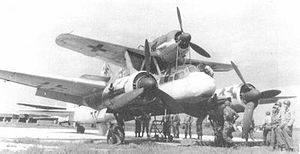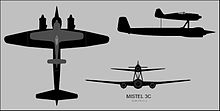- Mistel
-
 A captured example. United States Army personnel are examining the aircraft
A captured example. United States Army personnel are examining the aircraft
The Mistel (German for "Mistletoe"), also known as Beethoven-Gerät (Beethoven Device) and Vati und Sohn (Daddy and Son), was a Luftwaffe composite aircraft type of bomber, that appeared late in World War II.
The scheme originally involved replacing the entire nose-located crew compartment of a bomber airframe (usually a Junkers Ju 88 variant) with a specially-designed nose filled with a large load of explosive, and guiding it to its target by a fighter aircraft mounted above it on a set of struts. After releasing the bomber, the fighter would return to base. The first such composite aircraft flew in July 1943 and was promising enough to begin a programme by Luftwaffe test unit KG 200, code-named "Beethoven".
Contents
Design and development
The first such experiments in Nazi Germany concerning composite aircraft of any type were performed with the DFS 230 troop glider as the "lower" component, and using established, engine-powered Luftwaffe aircraft such as the Focke-Wulf Fw 56 or the Messerschmitt Bf 109E as the upper component, in an attempt to provide the troop glider with a longer range, than if it was simply towed in the conventional manner.
Later, the technique became more refined, and the bomber component (which was often a new aircraft rather than surplus) was fitted with a specialised 1,800 kg (3,960 lb) warhead. The final stage of Mistel development was the development of specialised purpose-built jet-powered bomber components, including ones developed from the Messerschmitt Me 262 and Junkers Ju 287 and the entirely new Arado Ar 234. None of these ambitious schemes left the drawing board before the end of the war.
Warhead
The definitive Mistel warhead was a very large shaped charge, of nearly two short tons in weight, and fitted with a copper or aluminium liner, similar to the warhead of the much smaller Panzerfaust anti-tank weapon. The warhead was expected to have a penetration of up to 7 meters of reinforced concrete.
Some 250 Mistels of various combinations were built during the war, but met with limited success. They were first flown in combat against the Allied invasion fleet during Battle of Normandy, targeting the British-held harbour at Courseulles-sur-Mer.
While Mistel pilots claimed hits, none of these can be correlated in Allied records, and they may have been made against the hulk of the old French battleship Courbet, which had been included as a component of the Mulberry harbour at Arromanches and specially dressed up as a decoy by the Allies. Serious blast and shrapnel damage from a near miss was also suffered by Scapa Flow in 1944, was abandoned after the loss of the Tirpitz led to the departure of all the Royal Navy's major surface units from the target.
As part of Operation Iron Hammer in late 1943 and early 1944, Mistels were selected to carry out key raids against Soviet weapons manufacturing facilities—specifically, electricity-generating power stations around Moscow and Gorky. These plants were known to be poorly defended by the Soviets and irreplaceable. However, before the plan could be implemented, the Red Army was already pushing into Germany itself and it was decided to use the Mistels against their bridgehead at Küstrin instead. On 12 April 1945, Mistels attacked the bridges being built there, but the damage caused was negligible and delayed the Soviet forces for only a day or two. Subsequent Mistel attacks on other bridges being thrown across the Oder were similarly ineffective.
Survivors
A Focke-Wulf Fw 190 (Werk Nr. 733682), preserved in the Imperial War Museum in London, was the fighter part of a Mistel system that was captured by British forces in 1945. The aircraft retains the Kugelverschraubung mit Sprengbolzen (balljoints with explosive bolts), the fittings underneath that attached it to its Junkers Ju 88 partner.[1][2]
Variants
- Mistel Prototype: Ju 88A-4 and Bf 109F-4
- Mistel 1: Ju 88A-4 and Bf 109F-4
- Mistel S1: Trainer version of Mistel 1
- Mistel 2: Ju 88G-l and Fw 190A-8 or F-8
- Mistel S2: Trainer version of Mistel 2
- Mistel 3A: Ju 88A-4 and Fw 190A-8
- Mistel S3A: Trainer version of Mistel 3A
- Mistel 3B: Ju 88H-4 and Fw 190A-8
- Mistel 3C: Ju 88G-10 and Fw 190F-8
- Mistel Führungsmaschine: Ju 88 A-4/H-4 and Fw 190 A-8
- Mistel 4: Ju 287 and Me 262
- Mistel 5: Arado E.377A and He 162
Mistel Combinations
In operative use
- Ju 88A-4/Bf 109F-4
- Ju 88A-4/Fw 190A-8
Projected for use
- Ju 88G-1/Fw 190A-6
- Ju 88A-6/Fw 190A-6
- Ju 88G-1/Fw 190F-8
- Ju 88H-4/Fw 190A-8
- Ju 88H-4/Fw 190F-8
Only in paper plans or proposed
- Ju 88 G-7/Ta 152H
- Ta 154/Fw 190
- Ar 234/Fi 103
- Do 217K/DFS 228
- Siebel Si 204/Lippisch DM-1
- Ju 287/Me 262
Operators
See also
References
- Citations
- ^ Forsyth, Robert = (2001). Mistel: German Composite Aircraft and Operations, 1942–1945. Midland Publishing. ISBN 1903223091=.
- ^ "Facts on the Sprengstoffträger Beethoven". 48 Special Models. http://www.48specialmodels.com/e-produkte/e-beeth.html. Retrieved 22 June 2011.
- Bibliography
- Green, William and Gordon Swanborough. "Prelude to 'Stand-Off'". Air Enthusiast, Thirty-four, September–December 1989. Bromley, UK: Fine Scroll. ISSN 0143-5450. pp. 43–47, 80.
- Wood, T. and Gunston, B. Hitler's Luftwaffe. Salamander, 1977.
External links
Categories:- Composite aircraft
- Guided bombs
- Luftwaffe guided missiles
- World War II guided missiles of Germany
Wikimedia Foundation. 2010.

